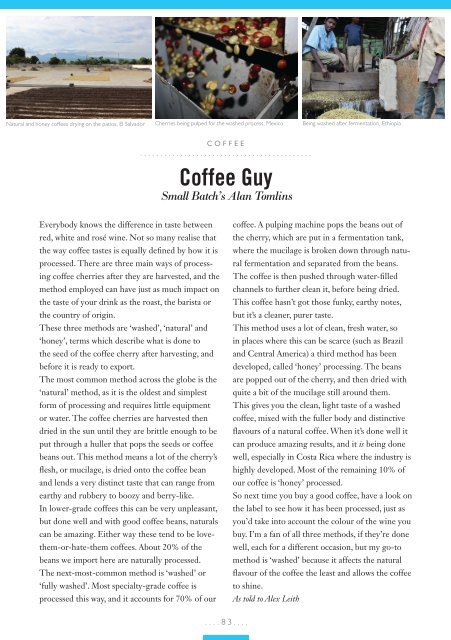Viva Brighton September 2015 Issue #31
- No tags were found...
You also want an ePaper? Increase the reach of your titles
YUMPU automatically turns print PDFs into web optimized ePapers that Google loves.
Natural and honey coffees drying on the patios, El Salvador Cherries being pulped for the washed process, Mexico Being washed after fermentation, Ethiopia<br />
coffee<br />
...........................................<br />
Coffee Guy<br />
Small Batch’s Alan Tomlins<br />
Everybody knows the difference in taste between<br />
red, white and rosé wine. Not so many realise that<br />
the way coffee tastes is equally defined by how it is<br />
processed. There are three main ways of processing<br />
coffee cherries after they are harvested, and the<br />
method employed can have just as much impact on<br />
the taste of your drink as the roast, the barista or<br />
the country of origin.<br />
These three methods are ‘washed’, ‘natural’ and<br />
‘honey’, terms which describe what is done to<br />
the seed of the coffee cherry after harvesting, and<br />
before it is ready to export.<br />
The most common method across the globe is the<br />
‘natural’ method, as it is the oldest and simplest<br />
form of processing and requires little equipment<br />
or water. The coffee cherries are harvested then<br />
dried in the sun until they are brittle enough to be<br />
put through a huller that pops the seeds or coffee<br />
beans out. This method means a lot of the cherry’s<br />
flesh, or mucilage, is dried onto the coffee bean<br />
and lends a very distinct taste that can range from<br />
earthy and rubbery to boozy and berry-like.<br />
In lower-grade coffees this can be very unpleasant,<br />
but done well and with good coffee beans, naturals<br />
can be amazing. Either way these tend to be lovethem-or-hate-them<br />
coffees. About 20% of the<br />
beans we import here are naturally processed.<br />
The next-most-common method is ‘washed’ or<br />
‘fully washed’. Most specialty-grade coffee is<br />
processed this way, and it accounts for 70% of our<br />
coffee. A pulping machine pops the beans out of<br />
the cherry, which are put in a fermentation tank,<br />
where the mucilage is broken down through natural<br />
fermentation and separated from the beans.<br />
The coffee is then pushed through water-filled<br />
channels to further clean it, before being dried.<br />
This coffee hasn’t got those funky, earthy notes,<br />
but it’s a cleaner, purer taste.<br />
This method uses a lot of clean, fresh water, so<br />
in places where this can be scarce (such as Brazil<br />
and Central America) a third method has been<br />
developed, called ‘honey’ processing. The beans<br />
are popped out of the cherry, and then dried with<br />
quite a bit of the mucilage still around them.<br />
This gives you the clean, light taste of a washed<br />
coffee, mixed with the fuller body and distinctive<br />
flavours of a natural coffee. When it’s done well it<br />
can produce amazing results, and it is being done<br />
well, especially in Costa Rica where the industry is<br />
highly developed. Most of the remaining 10% of<br />
our coffee is ‘honey’ processed.<br />
So next time you buy a good coffee, have a look on<br />
the label to see how it has been processed, just as<br />
you’d take into account the colour of the wine you<br />
buy. I’m a fan of all three methods, if they’re done<br />
well, each for a different occasion, but my go-to<br />
method is ‘washed’ because it affects the natural<br />
flavour of the coffee the least and allows the coffee<br />
to shine.<br />
As told to Alex Leith<br />
....83....


















